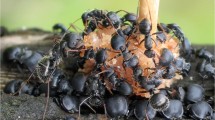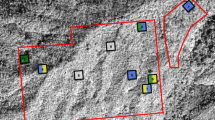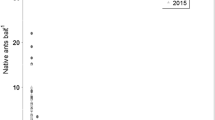Abstract
Ecologically dominant species can shape the assembly of ecological communities via altering competitive outcomes. Moreover, these effects may be amplified under limited niche differentiation. Nevertheless, the influences of ecological dominance and niche differentiation on assembly are rarely considered together. Here, we provide a novel examination of dominance in a diverse arboreal ant community, defining dominance by the prevalent usage of nesting resources and addressing how it influences community assembly. We first used a series of quantitative observational and experimental studies to address the natural nesting ecology, colony incidence on surveyed trees, and level of dominance over newly available nesting resources by our focal species, Cephalotes pusillus. The experimental studies were then used further to examine whether C. pusillus shapes assembly via an influence on cavity usage by co-occurring species. C. pusillus was confirmed as a dominant user of cavity nesting resources, with highly generalized nesting ecology, occupying about 50% of the trees within the focal system, and accounting for more than a third of new cavity occupation in experiments. Our experiments showed further that the presence of C. pusillus was associated with modest effects on species richness, but significant decreases in cavity-occupation levels and significant shifts in the entrance-size usage by co-occurring species. These results indicate that C. pusillus, as a dominant user of nesting resources, shapes assembly at multiple levels. Broadly, our findings highlight that complex interactions between a dominant species and the resource-usage patterns of other species can underlie species assembly in diverse ecological communities.



Similar content being viewed by others
References
Amarasekare P (2003) Competitive coexistence in spatially structured environments: a synthesis. Ecol Lett 6:1109–1122. https://doi.org/10.1046/j.1461-0248.2003.00530.x
Andersen AN (1992) Regulation of “momentary” diversity by dominant species in exceptionally rich ant communities of the Australian seasonal tropics. Am Nat 140:401–420. https://doi.org/10.1086/285419
Ashton IW, Miller AE, Bowman WD, Suding KN (2010) Niche complementarity due to plasticity in resource use: plant partitioning of chemical N forms. Ecology 91:3252–3260. https://doi.org/10.1890/09-1849.1
Bazzaz FA (1975) Plant species diversity in old-field successional ecosystems in southern Illinois. Ecology 56:485–488. https://doi.org/10.2307/1934981
Berendse F (1998) Effects of dominant plant species on soils during succession in nutrient-poor ecosystems. Biogeochemistry 1:73–88. https://doi.org/10.1023/A:1005935823525
Blüthgen N, Feldhaar H (2010) Food and shelter: how resources influence ant ecology. In: Lach L, Parr C, AbbotT K (eds) Ant ecology. Oxford University Press, Oxford, pp 115–136. https://doi.org/10.1093/acprof:oso/9780199544639.003.0007
Blüthgen N, Stork NE (2007) Ant mosaics in a tropical rainforest in Australia and elsewhere: a critical review. Austral Ecol 32:93–104. https://doi.org/10.1111/j.1442-9993.2007.01744.x
Calderón-Cortés N, Quesada M, Escalera-Vázquez LH (2011) Insects as stem engineers: interactions mediated by the twig-girdler Oncideres albomarginata chamela enhance arthropod diversity. PLoS ONE 6:e19083. https://doi.org/10.1371/journal.pone.0019083
Camacho GP, Vasconcelos HL (2015) Ants of the Panga Ecological Station, a Cerrado reserve in central Brazil. Sociobiology 62:281–295. https://doi.org/10.13102/sociobiology.v62i2.281-295
Camarota F, Powell S, Vasconcelos HL, Priest G, Marquis RJ (2015) Extrafloral nectaries have a limited effect on the structure of arboreal ant communities in a Neotropical savanna. Ecology 96:231–240. https://doi.org/10.1890/14-0264.1
Camarota F, Powell S, Melo AS, Priest G, Marquis RJ, Vasconcelos H (2016) Co-occurrence patterns in a diverse arboreal ant community are explained more by competition than habitat requirements. Ecol Evol 6:8907–8918. https://doi.org/10.1002/ece3.2606
Camarota F, Vasconcelos HL, Koch EBA, Powell S (2018) Discovery and defense define the social foraging strategy of neotropical arboreal ants. Behav Ecol Sociobiol 72:110. https://doi.org/10.1007/s00265-018-2519-1
Carroll CR (1979) A comparative study of two ant faunas: the stem-nesting ant communities of Liberia, West Africa and Costa Rica, Central America. Am Nat 113:551–561. https://doi.org/10.1086/283412
Cerdá X, Arnan X, Retana J (2013) Is competition a significant hallmark of ant (Hymenoptera: Formicidae) ecology. Myrmecol News 18:131–147
Chase JM, Leibold MA (2003) Ecological niches: linking classical and contemporary approaches. University of Chicago Press, Chicago. https://doi.org/10.7208/chicago/9780226101811.001.0001
Chesson P (2000) Mechanisms of maintenance of species diversity. Annu Rev Ecol S 31:343–366. https://doi.org/10.1146/annurev.ecolsys.31.1.343
Connell JH (1961) The influence of interspecific competition and other factors on the distribution of the barnacle Chthamalus stellatus. Ecology 42:710–723. https://doi.org/10.2307/1933500
Costa FV, Mello MAR, Bronstein JL, Guerra TJ, Muylaert RL, Leite AC, Neves FS, Nascimento FS (2016) Few ant species play a central role linking different plant resources in a network in rupestrian grasslands. PLoS ONE 11:e0167161. https://doi.org/10.1371/journal.pone.0167161
Dáttilo W, Díaz-Castelazo C, Rico- Gray V (2014) Ant dominance hierarchy determines the nested pattern in ant-plant networks. Biol J Linn Soc Lond 113:405–414. https://doi.org/10.1111/bij.12350
Davidson DW, Patrell-Kim L (1996) Tropical arboreal ants: why so abundant? In: Mildred E (ed) Neotropical biodiversity and conservation. Mathias Bothanical Garden, Los Angeles, pp 127–140
Davidson DW, Cook SC, Snelling RR, Chua TH (2003) Explaining the abundance of ants in lowland tropical rainforest canopies. Science 300:969–972. https://doi.org/10.1126/science.1082074
Dayton PK (1975) Experimental evaluation of ecological dominance in a rocky intertidal algal community. Ecol monogr 45:137–159. https://doi.org/10.2307/1942404
De Andrade ML, Urbani CB (1999) Diversity and adaptation in the ant genus Cephalotes, past and present. Staatliches Museum für Naturkunde, Karlsruhe
Dejean A, Corbara B (2003) A review of mosaics of dominant ants in rainforests and plantations. In: Basset Y, Kitching R, Miller S, Novotny V (eds) Arthropods of tropical forests: spatio-temporal dynamics and resource use in the canopy. Cambridge University Press, Cambridge, pp 341–347
Dejean A, Corbara B, Orivel J, Leponce M (2007) Rainforest canopy ants: the implications of territoriality and predatory behavior. Funct Ecosyst Communities 1:105–120
Dejean A, Fisher BL, Corbara B, Rarevohitra R, Randrianaivo R, Rajemison B, Leponce M (2010) Spatial distribution of dominant arboreal ants in a Malagasy coastal rainforest: gaps and presence of an invasive species. PLoS ONE 5:e9319. https://doi.org/10.1371/journal.pone.0009319
Díaz-Castelazo C, Rico-Gray V, Oliveira PS, Cuautle M (2004) Extrafloral nectary-mediated ant-plant interactions in the coastal vegetation of Veracruz, Mexico: richness, occurrence, seasonality and ant foraging patterns. Ecoscience 11:472–481. https://doi.org/10.1080/11956860.2004.11682857
Emery SM, Gross KL (2006) Dominant species identity regulates invasibility of old-field plant communities. Oikos 115:549–558. https://doi.org/10.1111/j.2006.0030-1299.15172.x
Floren A, Linsenmair KE (2000) Do ant mosaics exist in pristine lowland rain forests? Oecologia 123:129–137. https://doi.org/10.1007/s004420050998
Floren A, Biun A, Linsenmair EK (2002) Arboreal ants as key predators in tropical lowland rainforest trees. Oecologia 131:137–144. https://doi.org/10.1007/s00442-002-0874-z
Gibb H, Hochuli DF (2004) Removal experiment reveals limited effects of a behaviorally dominant species on ant assemblages. Ecology 85:648–657. https://doi.org/10.1890/03-0007
Greenslade P (1971) Interspecific competition and frequency changes among ants in Solomon Islands coconut plantations. J Appl Ecol 1:323–352. https://doi.org/10.2307/2402874
Guo Q, Rundel PW (1997) Measuring dominance and diversity in ecological communities: choosing the right variables. J Veg Sci 8:405–408. https://doi.org/10.2307/3237331
He F, Legendre P (2002) Species diversity patterns derived from species–area models. Ecology 83:1185–1198. https://doi.org/10.1890/0012-9658(2002)083[1185:SDPDFS]2.0.CO;2
Hillebrand H, Bennett DM, Cadotte MW (2008) Consequences of dominance: a review of evenness effects on local and regional ecosystem processes. Ecology 89:1510–1520. https://doi.org/10.1890/07-1053.1
Hoey AS, Bellwood DR (2009) Limited functional redundancy in a high diversity system: single species dominates key ecological process on coral reefs. Ecosystems 12:1316–1328. https://doi.org/10.1007/s10021-009-9291-z
Isbell FI, Polley HW, Wilsey BJ (2009) Species interaction mechanisms maintain grassland plant species diversity. Ecology 90:1821–1830. https://doi.org/10.1890/08-0514.1
Jackson DA (1984) Ant distribution patterns in a Cameroonian cocoa plantation: investigation of the ant mosaic hypothesis. Oecologia 62:318–324. https://doi.org/10.1007/BF00384263
Jiménez Soto E, Philpott SM (2015) Size matters: nest colonization patterns for twig-nesting ants. Ecol Evol 5:3288–3298. https://doi.org/10.1002/ece3.1555
Klimes P, Janda M, Ibalim S, Kua J, Novotny V (2011) Experimental suppression of ants foraging on rainforest vegetation in New Guinea: testing methods for a whole-forest manipulation of insect communities. Ecol Entomol 36:94–103. https://doi.org/10.1111/j.1365-2311.2010.01250.x
Koch E, Camarota F, Vasconcelos HL (2015) Plant ontogeny as a conditionality factor in the protective effect of ants on a neotropical tree. Biotropica 48:198–205. https://doi.org/10.1111/btp.12264
Leponce M, Delabie JH, Orivel J, Jacquemin J, Martin MC, Dejean A (2019) Tree-dwelling ant survey (Hymenoptera, Formicidae) in Mitaraka, French Guiana. Zoosystema 40:163–179. https://doi.org/10.5252/zoosystema2019v41a10
Leston D (1978) A neotropical ant mosaic. Ann Entomol Soc Am 71:649–653. https://doi.org/10.1093/aesa/71.4.649
Levine JM, HilleRisLambers J (2009) The importance of niches for the maintenance of species diversity. Nature 461:254–257. https://doi.org/10.1038/nature08251
MacArthur RH (1957) On the relative abundance of bird species. Proc Natl Acad Sci USA 43:293–295. https://doi.org/10.1073/pnas.43.3.293
MacArthur RH (1958) Population ecology of some warblers of northeastern coniferous forests. Ecology 39:599–619. https://doi.org/10.2307/1931600
MacArthur RH (1965) Patterns of species diversity. Biol Rev 40:510–533. https://doi.org/10.1111/j.1469-185X.1965.tb00815.x
Majer JD (1972) The ant mosaic in Ghana cocoa farms. Bull Entomol Res 62:151–160. https://doi.org/10.1017/S0007485300047593
Majer JD (1990) The abundance and diversity of arboreal ants in northern Australia. Biotropica 1:191–199. https://doi.org/10.2307/2388412
McKane RB, Johnson LC, Shaver GR, Nadelhoffer KJ, Rastetter EB, Fry B, Giblin AE, Kielland K, Kwiatkowski BL, Laundre JA, Murray G (2002) Resource-based niches provide a basis for plant species diversity and dominance in arctic tundra. Nature 415:68–71. https://doi.org/10.1038/415068a
McNaughton ST (1968) Structure and function in California grasslands. Ecology 49:962–972. https://doi.org/10.2307/1936547
McNaughton SJ, Wolf LL (1970) Dominance and the niche in ecological systems. Science 167:131–139. https://doi.org/10.1126/science.167.3915.131
Morse DH (1974) Niche breadth as a function of social dominance. Am Nat 108:818–830. https://doi.org/10.1086/282957
Mottl O, Yombai J, Fayle TM, Novotný V, Klimeš P (2020) Experiments with artificial nests provide evidence for ant community stratification and nest site limitation in a tropical forest. Biotropica 52:277–287. https://doi.org/10.1111/btp.12684
Oliveira-Filho AT, Ratter JA (2002) Vegetation physiognomies and woody flora of the cerrado biome. In: Oliveira PS, Marquis RJ (eds) The Cerrados of Brazil: ecology and natural history of a Neotropical savanna. Columbia University Press, New York, pp 91–120. https://doi.org/10.7312/oliv12042-007
Paine RT (1971) A short-term experimental investigation of resource partitioning in a New Zealand rocky intertidal habitat. Ecology 52:1096–1106. https://doi.org/10.2307/1933819
Parr CL, Gibb H (2012) The discovery–dominance trade-off is the exception, rather than the rule. J Anim Ecol 81:233–241. https://doi.org/10.1111/j.1365-2656.2011.01899.x
Pfeiffer M, Cheng TH, Chong LT (2008) Exploring arboreal ant community composition and co-occurrence patterns in plantations of oil palm Elaeis guineensis in Borneo and Peninsular Malaysia. Ecography 3:21–32. https://doi.org/10.1111/j.2007.0906-7590.05172.x
Philpott SM (2010) A canopy dominant ant affects twig-nesting ant assembly in coffee agroecosystems. Oikos 119:1954–1960. https://doi.org/10.1111/j.1600-0706.2010.18430.x
Philpott SM, Foster PF (2005) Nest-site limitation in coffee agroecosystems: artificial nests maintain diversity of arboreal ants. Ecol Appl 15:1478–1485. https://doi.org/10.1890/04-1496
Philpott SM, Serber Z, De la Mora A (2018) Influences of species interactions with aggressive ants and habitat filtering on nest colonization and community composition of arboreal twig-nesting ants. Environ Entomol 47:309–317. https://doi.org/10.1093/ee/nvy015
Powell S (2008) Ecological specialization and the evolution of a specialized caste in Cephalotes ants. Funct Ecol 22:902–911. https://doi.org/10.1111/j.1365-2435.2008.01436.x
Powell S (2009) How ecology shapes caste evolution: linking resource use, morphology, performance and fitness in a superorganism. J Evol Biol 22:1004–1013. https://doi.org/10.1111/j.1420-9101.2009.01710.x
Powell S (2016) A comparative perspective on the ecology of morphological diversification in complex societies: nesting ecology and soldier evolution in the turtle ants. Behav Ecol Sociobiol 80:1075–1085. https://doi.org/10.1007/s00265-016-2080-8
Powell S, Dornhaus A (2013) Soldier-based defences dynamically track resource availability and quality in ants. Anim Behav 85:157–164. https://doi.org/10.1016/j.anbehav.2012.10.020
Powell S, Costa AN, Lopes CT, Vasconcelos HL (2011) Canopy connectivity and the availability of diverse nesting resources affect species coexistence in arboreal ants. J Anim Ecol 80:352–360. https://doi.org/10.1111/j.1365-2656.2010.01779.x
Powell S, Donaldson MM, Woodrow TA, Dornhaus A (2017) Context-dependent defences in turtle ants: resource defensibility and threat level induce dynamic shifts in soldier deployment. Funct Ecol 31:2287–2298. https://doi.org/10.1111/1365-2435.12926
Powell S, Price SL, Kronauer DJ (2020) Trait evolution is reversible, repeatable, and decoupled in the soldier caste of turtle ants. Proc Natl Acad Sci USA 117:6608–6615. https://doi.org/10.1073/pnas.1913750117
Price PW (1971) Niche breadth and dominance of parasitic insects sharing the same host species. Ecology 52:587–596. https://doi.org/10.2307/1934146
R Core Team (2018) R: a language and environment for statistical computing. R Foundation for Statistical Computing, Vienna
Ribas C, Oliveira P, Sobrinho T, Schoereder J, Madureira M (2010) The arboreal ant community visiting extrafloral nectaries in the Neotropical cerrado savanna. Terr Arthropod Rev 3:3–27. https://doi.org/10.1163/187498310X487785
Room PM (1971) The relative distributions of ant species in Ghana's cocoa farms. J Anim Ecol 1:735–751. https://doi.org/10.2307/3447
Sanders NJ, Crutsinger GM, Dunn RR, Majer JD, Delabie JH (2007) An ant mosaic revisited: dominant ant species disassemble arboreal ant communities but co-occur randomly. Biotropica 39:422–427. https://doi.org/10.1111/j.1744-7429.2007.00263.x
Sasaki T, Lauenroth WK (2011) Dominant species, rather than diversity, regulates temporal stability of plant communities. Oecologia 166:761–768. https://doi.org/10.1007/s00442-011-1916-1
Satoh T, Yoshida T, Koyama S, Yamagami A, Takata M, Kurachi T, Hayashi S, Hirobe T, Hata Y (2016) Resource partitioning based on body size contributes to the species diversity of wood-boring beetles and arboreal nesting ants. Insect Conserv Diver 9:4–12. https://doi.org/10.1111/icad.12136
Stuble KL, Jurić I, Cerdá X, Sanders NJ (2017) Dominance hierarchies are a dominant paradigm in ant ecology (Hymenoptera: Formicidae), but should they be? And what is a dominance hierarchy anyways? Myrmecol News 24:71–81
Svanbäck R, Bolnick DI (2007) Intraspecific competition drives increased resource use diversity within a natural population. Proc R Soc Lond (Biol) 274:839–844. https://doi.org/10.1098/rspb.2006.0198
Tilman GD (1984) Plant dominance along an experimental nutrient gradient. Ecology 65:1445–1453. https://doi.org/10.2307/1939125
Tobin JE (1991) A neotropical rainforest canopy, ant community: some ecological considerations. In: Huxley CR, Cutler DF (eds) Ant–plant interactions. Oxford University Press, Oxford, pp 536–638
Turcotte MM, Levine JM (2016) Phenotypic plasticity and species coexistence. Trends Ecol Evol 31:803–813. https://doi.org/10.1016/j.tree.2016.07.013
Valone TJ, Brown JH (1995) Effects of competition, colonization, and extinction on rodent species diversity. Science 1(267):10. https://doi.org/10.1126/science.7846530
Vasconcelos HL, Maravalhas JB, Feitosa RM, Pacheco R, Neves KC, Andersen AN (2018) Neotropical savanna ants show a reversed latitudinal gradient of species richness, with climatic drivers reflecting the forest origin of the fauna. J Biogeogr 45:248–258. https://doi.org/10.1111/jbi.13113
Whittaker RH (1965) Dominance and diversity in land plant communities. Science 147:250–260. https://doi.org/10.1126/science.147.3655.250
Winfree R, Fox WJ, Williams NM, Reilly JR, Cariveau DP (2015) Abundance of common species, not species richness, drives delivery of a real-world ecosystem service. Ecol Lett 18:626–635. https://doi.org/10.1111/ele.12424
Acknowledgements
The authors would like to thank M. Gonzaga, R. Feitosa, R. Pacheco, S. Sendoya, and two anonymous reviewers for valuable comments on prior versions of this manuscript. We also would like to thank E.B.A. Koch, J. Vieira, and L. Silva for help in the field and processing material. This work was funded by National Science Foundation grants DEB 0842144 for all authors. FC and SP had additional funding from National Science Foundation grant DEB 1442256 and the George Washington University. FC and HLV had additional funding from the Brazilian Council of Research and Scientific Development (CNPQ), and the Brazilian Ministry for Education (MEC/CAPES).
Author information
Authors and Affiliations
Contributions
FC, HLV, RJM, and SP conceived and designed the study. FC, HLV, RJM, and SP performed the data collection. FC, HLV, and SP analyzed the data. FC, HLV, RJM, and SP wrote the manuscript.
Corresponding author
Additional information
Communicated by Konrad Fiedler.
Electronic supplementary material
Below is the link to the electronic supplementary material.
Rights and permissions
About this article
Cite this article
Camarota, F., Vasconcelos, H.L., Marquis, R.J. et al. Revisiting ecological dominance in arboreal ants: how dominant usage of nesting resources shapes community assembly. Oecologia 194, 151–163 (2020). https://doi.org/10.1007/s00442-020-04748-z
Received:
Accepted:
Published:
Issue Date:
DOI: https://doi.org/10.1007/s00442-020-04748-z




